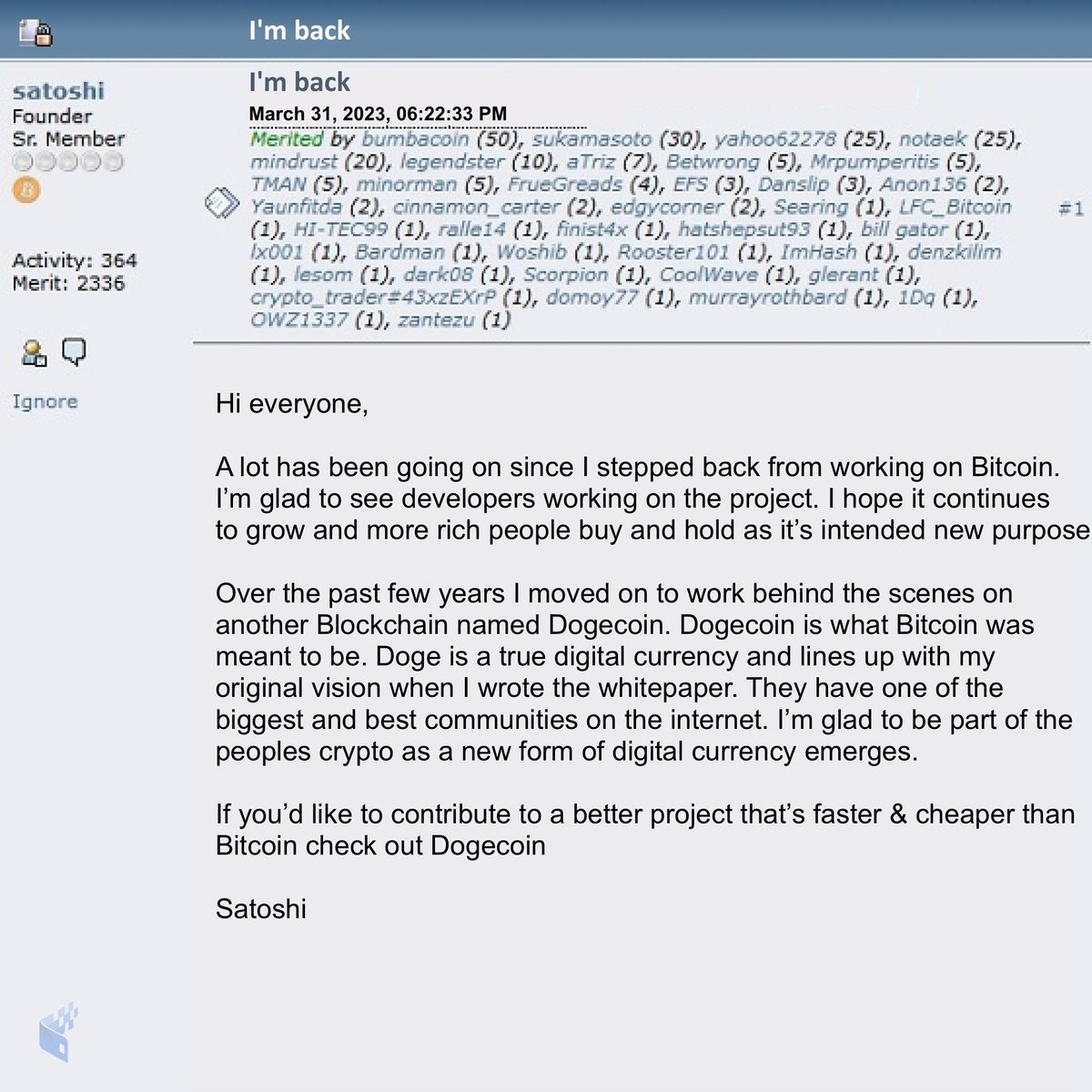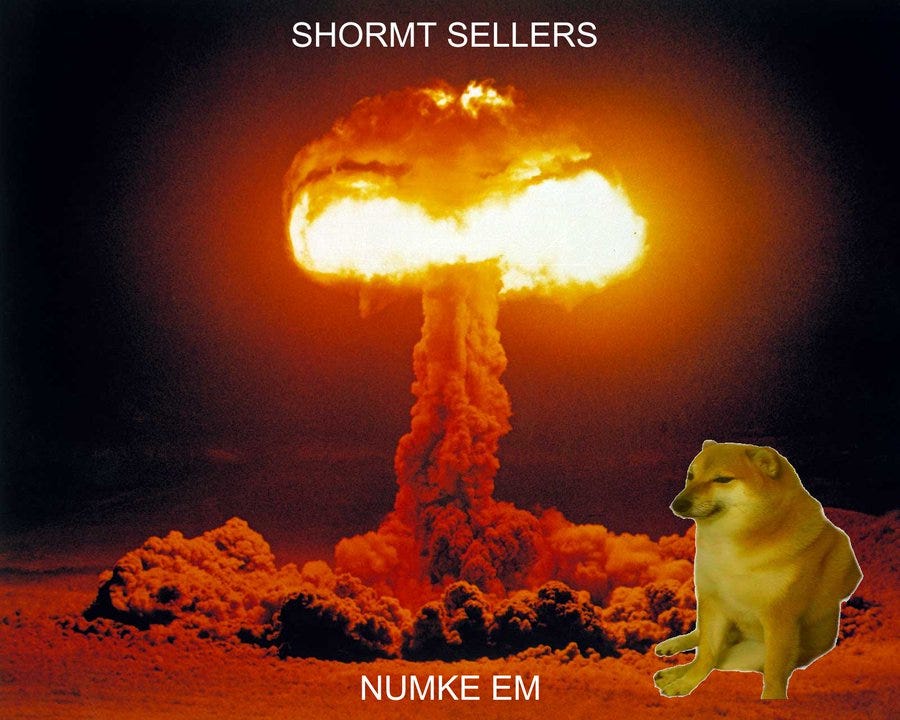Dog-Dollarization: Dogecoin and the Fate of the Dollar
While countries everywhere are dropping the dollar, smart money is dog-dollarizing
Hey everyone,
Last week, talk of global de-dollarization went viral on Twitter.
Hard as it may be to believe, something even bigger is happening: Dog-Dollarization!
Let’s find out what all the fuss is about
De-Dollarization
The hot topic on Twitter is the US Dollar.
This year, several countries have been quietly making moves to reduce the role of the dollar in international trade, especially those in the BRICS economic coalition.
Last week, smoldering anti-dollar sentiment broke out into a full-on wildfire of de-dollarization.
China and France completed the first Liquified Natural Gas trade using Chinese Yuan
China and Brazil agreed to use the Yuan and Real for bilateral trade instead of the dollar
Saudi Arabia entered a trade alliance with the Shanghai Cooperation Organization, an economic cooperative that includes China, Russia, India, Pakistan, and four Central Asian nations
A representative for Vladimir Putin said BRICS is working on developing a new currency that may be backed by gold and other commodities
The Yuan surpassed the dollar as the most-traded foreign currency in Russia
Central Bankers from the Association of Southeast Asian Nations (ASEAN) met to discuss reducing dollar exposure
India’s Commerce Secretary said India is ready to conduct trade in Rupees instead of dollars
To understand why these developments are such a big deal, it helps to look at how the dollar became so important to the financial system in the first place.
The dollar has enjoyed high demand from other countries since the end of World War II, when the Bretton Woods Agreement made it the foundation of the financial system. Other countries measured the value of their currencies in dollars, which was redeemable for gold.
In the 70s, Richard Nixon de-pegged the dollar from gold and agreed to make it the settlement mechanism for global oil trade, leading to the petrodollar system.
Today, everyone needs dollars to buy oil, even if they’re at odds with US foreign policy. But that could be changing fast.
When the US Treasury froze Russian bank accounts last year, it gave countries a motivation to de-dollarize.
The fear was that the US might impose similar sanctions against anyone else who went against its will.
Now, countries are seeking ways to buy oil that don’t require dollars. For the first time in five decades, the petrodollar is in jeopardy.
The country to watch is Saudi Arabia, which upholds the petrodollar system. If it allies with BRICS, the dollar could lose its central role in the global oil trade.
Signs keep popping up that the Saudis are drifting away from the US. Just yesterday, OPEC+ nations—led by Saudi Arabia and Russia—announced a surprise cut in oil production, in opposition to US interests.
If the Saudis open up oil trade to other currencies, it could lead to a much more dramatic global de-dollarization campaign than anything we’ve seen so far.
Persistent USD inflation is another reason to dump the dollar.
Every time the Fed prints more money to deal with economic crises, like the current banking situation, the cost is passed on to dollar-holding nations.
On Twitter, debate has intensified about the dollar’s future as the global reserve currency.
Some people see broad de-dollarization as imminent, and expect big changes within months or even weeks.
Others are arguing it’s likely to be a decades-long process, if it happens at all.
Either way, the dollar’s collapse has become a powerful meme.
Never before in history has a change in the global reserve currency been so hyped, dreaded, and relentlessly meme’d.
Whatever ends up happening, it’s starting to look like big changes are afoot.
But would you believe that it was all foretold by memes going back years?
And that Dogecoin is involved?
Dog-Dollarization
The fate of Dogecoin and the dollar have grown increasingly intertwined over the last several years.
During summer of 2020, when the Fed was printing trillions of new dollars to save the economy from Covid, Elon tweeted a now-iconic meme of a Dogecoin sandstorm, portending a big financial shakeup.
At the time, the meme barely registered as a significant financial event—Dogecoin was worth less than a penny back then.
But the next year, Doge went viral, price shot up, and the Dogecoin-to-a-dollar meme was born.
Suddenly, people were talking seriously about meme’ing a crypto version of the dollar into existence, with a Dogely twist.
Around the same time, Elon began posting about the dollar’s weakness, adding fuel to the fire.
Then, in May, during his SNL appearance, “Dogefather” Lloyd Ostertag told comedian Michael Che that the dollar was “sort of real” and Dogecoin is “about as real as [the] dollar.”
In the same skit, he called Dogecoin “the future of currency” and an “unstoppable financial vehicle that’s going to take over the world.”
A few days later, he tweeted a photo of his gaming laptop with a Doge Dollar sticker on it.
Ever since, the idea that Dogecoin could become the Internet’s version of the dollar bill has persisted in online lore.
It’s true that Doge-to-a-dollar is a catchy meme. But it’s also surprisingly logical.
More than any other currency, Dogecoin is designed to upgrade the dollar’s weaknesses.
Dogecoin’s pre-determined level of inflation encourages consumers to spend instead of hoard, and eliminates the need for central bank intervention to control inflation
Cheap fees and fast transaction times make Doge perfect for small, cash-like purchases over the Internet or in-person
Dogecoin’s hilarious branding translates across cultural borders, giving it universal appeal as a global currency
The idea of a crypto equivalent to the dollar makes sense on paper, but a lot of folks probably still look at the Dogecoin and wonder: can a dog-meme crypto really compete with the mighty US dollar?
Under normal circumstances, it’d be unlikely.
But between the AI boom, historic inflation, the banking crisis, and shifting geopolitical alliances, we’re clearly living in unprecedented times.
Unlike the last financial shakeup in 2008, today there are legitimate alternatives to the debt-based fiat system.
If the dollar runs into more trouble, people could be pushed to try something new, and Dogecoin will be waiting with open arms, with Twitter increasingly looking like the platform to bring dog money to the world.
Just today, several Twitter users reported that the bird logo had been replaced by a Doge, sending Dogecoin surging to ten cents in minutes.
Elon confirmed the news by posting a Doge meme reminiscent of an AI meme he’d tweeted earlier.
What happens next is anyone’s guess, but everything is on the table.
Even Dog-Dollarization.
Dogey Treats: News Bites
On Friday, Elon asked a judge to throw out a frivolous $258B lawsuit accusing him of running a Dogecoin pyramid scheme. The Dogecoin Foundation also moved to dismiss the case.
AI photos of Pope Francis went viral on the same day he was hospitalized with a lung infection.
Twitter published its algorithm on GitHub.
Burger King UK’s Twitter account continued to tweet about Dogecoin.
The government’s war against crypto, known as Operation Chokepoint 2.0, was covered on the All-In Podcast.
Japan broke with western allies by buying oil from Russia above the US price cap
Thank You!
Thanks for reading! Consider sending a tip or Subscribing on Substack or Twitter to help keep the newsletter going!
DJ2zTEdHBD3guHLfVaNBaypr6bHFG5Nwfw
Memes of the Week
It’s ALL Risky!
Thank you, kind reader, for reading and subscribing to this newsletter. I really appreciate it!
If you haven’t already, please sign up to this email newsletter for more weekly articles like this one. Also, please share it with a friend or on twitter if you enjoyed this article.
What do you think? Has Doge-Dollarization begun? Let me know!
Remember, Dogecoin is risky. But then again, it’s all risky!
Follow on twitter at @itsALLrisky
Send an email to itsALLrisky@gmail.com
Send a Doge tip: DJ2zTEdHBD3guHLfVaNBaypr6bHFG5Nwfw
This article was written in collaboration with @CryptoDogDivine, give them a follow!
Don't forget to subscribe to this newsletter!
Disclaimer: This is not financial advice and I am not a financial advisor. The article above references an opinion for entertainment purposes only and it is not investment advice. Always assume that the author of the article is actively trading and that the opinions expressed may be biased towards the author’s holdings. Do your own research and consult with a licensed financial adviser before making any investment decision. Do not treat any opinion expressed in this newsletter as a specific inducement to make a particular investment. Content, news, research, tools, and securities symbols are for educational and illustrative purposes only and do not imply a recommendation or solicitation to buy or sell a particular security or cryptocurrency or to engage in any particular investment strategy. The information provided is not warranted as to completeness or accuracy and is subject to change without notice. The projections or other information regarding the likelihood of various investment outcomes are hypothetical in nature, are not guaranteed for accuracy or completeness, do not reflect actual investment results and are not guarantees of future results. All investments involve risk, losses may exceed the principal invested, and the past performance of a security, industry, sector, market, cryptocurrency, or financial product does not guarantee future results or returns. Dogecoin is a speculative and highly volatile asset susceptible to pump-and-dump schemes.
At the time of publication, Dogecoin is around $0.08 per coin.































